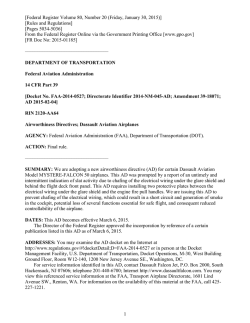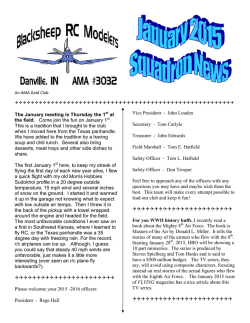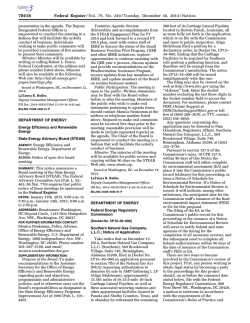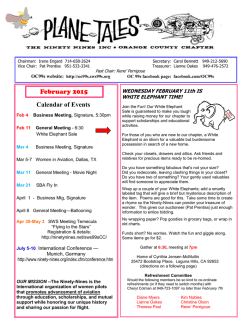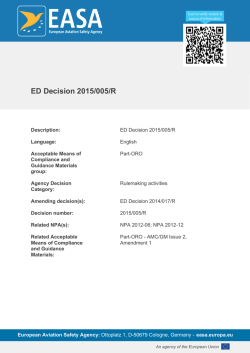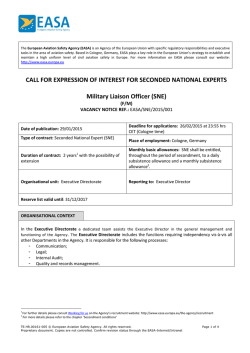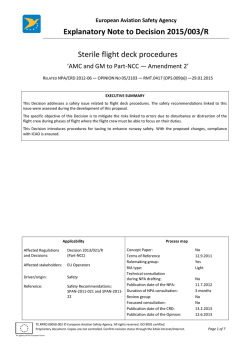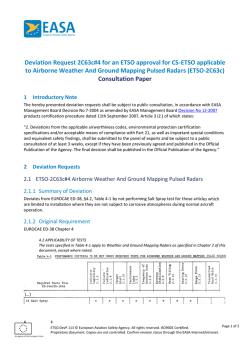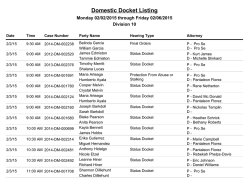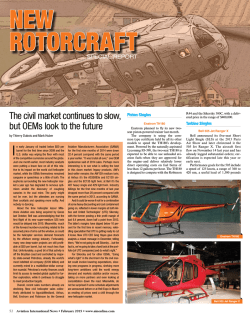
Federal Register Volume 80, Number 21 (Monday, February 2, 2015)
[Federal Register Volume 80, Number 21 (Monday, February 2, 2015)] [Rules and Regulations] [Pages 5454-5457] From the Federal Register Online via the Government Printing Office [www.gpo.gov] [FR Doc No: 2015-01800] –––––––––––––––––––––––––––––––––– DEPARTMENT OF TRANSPORTATION Federal Aviation Administration 14 CFR Part 39 [Docket No. FAA-2015-0049; Directorate Identifier 2014-SW-037-AD; Amendment 39-18096; AD 2015-02-27] RIN 2120-AA64 Airworthiness Directives; Airbus Helicopters (Previously Eurocopter France) Helicopters AGENCY: Federal Aviation Administration (FAA), DOT. ACTION: Final rule; request for comments. –––––––––––––––––––––––––––––––––– SUMMARY: We are superseding Airworthiness Directive (AD) 2013-19-19 for certain Eurocopter France Model AS332C, AS332L, AS332L1, AS332L2, and EC225LP helicopters. AD 2013-19-19 required replacing certain serial-numbered main gearbox (MGB) bevel gear vertical shafts and inspecting and replacing, if necessary, each MGB bevel gear vertical shaft (shaft). This new AD requires the same actions as AD 2013-19-19 but corrects an error in the term used to identify an inspection qualification and updates the type certificate holder's name. This AD is prompted by two incidents of emergency ditching after warning indications of loss of MGB oil pressure. These actions are intended to detect a cracked shaft, which could result in loss of MGB oil pressure, loss of the MGB lubrication system, and subsequent loss of control of the helicopter. DATES: This AD is effective February 17, 2015. We must receive comments on this AD by April 3, 2015. ADDRESSES: You may send comments by any of the following methods: • Federal eRulemaking Docket: Go to http://www.regulations.gov. Follow the online instructions for sending your comments electronically. • Fax: 202-493-2251. • Mail: Send comments to the U.S. Department of Transportation, Docket Operations, M-30, West Building Ground Floor, Room W12-140, 1200 New Jersey Avenue SE., Washington, DC 20590-0001. • Hand Delivery: Deliver to the ''Mail'' address between 9 a.m. and 5 p.m., Monday through Friday, except Federal holidays. 1 Examining the AD Docket You may examine the AD docket on the Internet at http://www.regulations.gov or in person at the Docket Operations Office between 9 a.m. and 5 p.m., Monday through Friday, except Federal holidays. The AD docket contains this AD, the European Aviation Safety Agency (EASA) AD, the economic evaluation, any comments received, and other information. The street address for the Docket Operations Office (telephone 800-647-5527) is in the ADDRESSES section. Comments will be available in the AD docket shortly after receipt. For service information identified in this AD, contact Airbus Helicopters, Inc., 2701 N. Forum Drive, Grand Prairie, TX 75052; telephone (972) 641-0000 or (800) 232-0323; fax (972) 641-3775; or at http://www.airbushelicopters.com/techpub. You may review the referenced service information at the FAA, Office of the Regional Counsel, Southwest Region, 2601 Meacham Blvd., Room 663, Fort Worth, Texas 76137. FOR FURTHER INFORMATION CONTACT: James Blyn, Aviation Safety Engineer, Regulations and Policy Group, Rotorcraft Directorate, FAA, 2601 Meacham Blvd., Fort Worth, Texas 76137; telephone (817) 222-5110; email [email protected]. SUPPLEMENTARY INFORMATION: Comments Invited This AD is a final rule that involves requirements affecting flight safety, and we did not provide you with notice and an opportunity to provide your comments prior to it becoming effective. However, we invite you to participate in this rulemaking by submitting written comments, data, or views. We also invite comments relating to the economic, environmental, energy, or federalism impacts that resulted from adopting this AD. The most helpful comments reference a specific portion of the AD, explain the reason for any recommended change, and include supporting data. To ensure the docket does not contain duplicate comments, commenters should send only one copy of written comments, or if comments are filed electronically, commenters should submit them only one time. We will file in the docket all comments that we receive, as well as a report summarizing each substantive public contact with FAA personnel concerning this rulemaking during the comment period. We will consider all the comments we receive and may conduct additional rulemaking based on those comments. Discussion On September 9, 2013, we issued AD 2013-19-19 (78 FR 60188, October 1, 2013), which required replacing certain serial-numbered shafts because they are no longer airworthy. Also, AD 2013-19-19 required certain inspections at specified intervals of each shaft for a crack and, if there is a crack, replacing the shaft with an airworthy part before further flight. AD 2013-19-19 was prompted by two incidents of emergency ditching after warning indication of loss of oil pressure. A full circumferential crack of the lower shaft occurred in the area where two sections of the shaft are welded together. As a result, the shaft stopped driving the main and backup oil pumps, leading to warning indications of the loss of the MGB lubrication. The crew activated the MGB emergency lubrication system, and following a warning that indicated failure of that system, performed a controlled ditching into the sea. The actions in AD 2013-19-19 were intended to detect a cracked shaft, which could result in loss of MGB oil pressure, loss of the MGB lubrication system, and subsequent loss of control of the helicopter. AD 2013-19-19 was prompted by AD No. 2013-0138R1, dated July 15, 2013, issued by EASA, which is the Technical Agent for the Member States of the European Union, to correct an unsafe condition for the Eurocopter Model AS332C, AS332C1, AS332L, AS332L1, AS332L2, and 2 EC225LP helicopters, all serial numbers, with certain part-numbered shafts, installed. EASA advises of two events of the Model EC225LP helicopters where an emergency ditching was performed after warning indication of MGB loss of oil pressure and subsequent additional red alarm on the MGB emergency lubrication system (EMLUB). EASA also advises of a full circumferential crack of the lower shaft in the area where the two sections of the shaft are welded together. As a result, the vertical shaft ceased to drive the main and backup oil pumps leading to warning indications of the loss of the MGB main and standby oil lubrication systems. The crew activated the EMLUB system and, following a subsequent warning indicating failure of that system, performed a controlled ditching into the sea. EASA advises that Eurocopter determined after investigating the incidents that the shaft failures resulted from a combination of factors, including stress hot-spots induced by the shaft geometry, residual stresses in the shaft weld material resulting from the manufacturing process, and corrosion pitting inside the shaft on areas where gear spline wear particles accumulated. The EASA AD allows continued operations under certain conditions if equipped with a Vibration Health Monitoring System (VHM). Actions Since We Issued AD 2013-19-19 After we issued AD 2013-19-19 (78 FR 60188, October 1, 2013), we discovered an incorrect term used to identify the inspection qualification for one of the inspections in the AD. Specifically, the AD included in the Required Actions section, under paragraph (e)(3)(ii), the following: ''Before further flight and thereafter at intervals not to exceed 11.5 hours TIS, remove the main jet and emergency spraying jet, and ultrasonic inspect the shaft in the weld area for a crack, which must be done by a Level II or Level III inspector certified in the eddy current fault detection method in the Aeronautics Sector according to the EN4179 or NAS410 standard, or''. As published, the term ''eddy current'' used to identify the inspection qualification is incorrect. The correct term is ''ultrasonic.'' Also, since the issuance of AD 2013-19-19, the type certificate holder's name changed from Eurocopter France to Airbus Helicopters. This AD requires the same actions as AD 2013-19-19 but corrects the inspection qualification and updates the type certificate holder's name. FAA's Determination These helicopters have been approved by the aviation authority of France and are approved for operation in the United States. Pursuant to our bilateral agreement with France, EASA, its technical representative, has notified us of the unsafe condition described in the EASA AD. We are issuing this AD because we evaluated all information provided by EASA and determined the unsafe condition exists and is likely to exist or develop on other helicopters of these same type designs. Interim Action We consider this AD interim action. The design approval holder is currently developing a newlydesigned shaft that will address the unsafe condition identified in this AD. Once the newly-designed shaft is developed, approved, and available, we might consider additional rulemaking. Related Service Information Eurocopter (now Airbus Helicopters) issued the following service information: 3 • • Alert Service Bulletin (ASB) No. AS332-01.00.82, Revision 3, dated July 8, 2013, for the Model AS332C, C1, L, L1, L2 civil helicopters and Model AS332B, B1, M, M1, and F1 military model helicopters. The ASB defines inspection requirements to detect a crack in the shaft, and ASB No. EC225-04A009, Revision 3, dated July 8, 2013 for Model EC225LP helicopters. The ASB defines inspection requirements to detect a crack in the shaft. AD Requirements This AD requires: • Removing certain part-numbered and serial-numbered shafts that are no longer considered airworthy from service. • For certain model helicopters, before further flight and at specified intervals, eddy current inspecting the shaft for a crack in the area of the weld. • For Model EC225LP helicopters, before further flight, either installing a placard in full view of the pilot with the following statement in red, 6 millimeter letters on a white background: ''MAXIMUM CONTINUOUS TORQUE LIMITED TO 70% DURING LEVEL FLIGHTS AT IAS EQUAL TO OR MORE THAN 60 KTS,'' and before further flight and thereafter at intervals not to exceed 11.5 hours TIS, removing the main jet and emergency spraying jet, and ultrasonic inspecting the shaft in the weld area for a crack; or • Before further flight and thereafter at intervals not to exceed 8 hours TIS, removing the main jet and emergency spraying jet, and ultrasonic inspecting the shaft for a crack in the area of the weld. • Each eddy current or ultrasonic inspection be done by a Level II or Level III operator certified in the eddy current or ultrasonic fault detection method in the Aeronautics Sector according to the EN4179 or NAS410 standard. • If there is a crack, before further flight, replacing the shaft with an airworthy part. Differences Between This AD and the EASA AD The EASA AD allows continued operations under certain conditions if equipped with a VHM. The VHM system is validated by FAA for information only, and therefore we have not adopted that portion of the EASA AD. Costs of Compliance We estimate that this AD affects 4 helicopters of U.S. Registry and that operators may incur the following costs to comply with this AD. At $85 per work hour; minimal cost to install a placard; and 3 work hours to inspect each shaft for a crack, it will cost $255 per helicopter and $1,020 for the fleet per inspection. It will take 44 work hours to replace a shaft and $1,243,350 for required parts for a total of $1,247,090 per helicopter. FAA's Justification and Determination of the Effective Date Providing an opportunity for public comments before adopting these AD requirements would delay implementing the safety actions needed to correct this known unsafe condition. Therefore, we find that the risk to the flying public justifies waiving notice and comment before adopting this rule because the required corrective actions must be done within 10 hours TIS and at repeated intervals within short time periods. 4 Since an unsafe condition exists that requires the immediate adoption of this AD, we determined that notice and opportunity for public comment before issuing this AD are impracticable and that good cause exists for making this amendment effective in less than 30 days. Authority for This Rulemaking Title 49 of the United States Code specifies the FAA's authority to issue rules on aviation safety. Subtitle I, section 106, describes the authority of the FAA Administrator. ''Subtitle VII: Aviation Programs,'' describes in more detail the scope of the Agency's authority. We are issuing this rulemaking under the authority described in ''Subtitle VII, Part A, Subpart III, Section 44701: General requirements.'' Under that section, Congress charges the FAA with promoting safe flight of civil aircraft in air commerce by prescribing regulations for practices, methods, and procedures the Administrator finds necessary for safety in air commerce. This regulation is within the scope of that authority because it addresses an unsafe condition that is likely to exist or develop on products identified in this rulemaking action. Regulatory Findings We determined that this AD will not have federalism implications under Executive Order 13132. This AD will not have a substantial direct effect on the States, on the relationship between the national Government and the States, or on the distribution of power and responsibilities among the various levels of government. For the reasons discussed, I certify that this AD: 1. Is not a ''significant regulatory action'' under Executive Order 12866; 2. Is not a ''significant rule'' under DOT Regulatory Policies and Procedures (44 FR 11034, February 26, 1979); 3. Will not affect intrastate aviation in Alaska to the extent that it justifies making a regulatory distinction; and 4. Will not have a significant economic impact, positive or negative, on a substantial number of small entities under the criteria of the Regulatory Flexibility Act. We prepared an economic evaluation of the estimated costs to comply with this AD and placed it in the AD docket. List of Subjects in 14 CFR Part 39 Air transportation, Aircraft, Aviation safety, Incorporation by reference, Safety. Adoption of the Amendment Accordingly, under the authority delegated to me by the Administrator, the FAA amends 14 CFR part 39 as follows: PART 39–AIRWORTHINESS DIRECTIVES 1. The authority citation for part 39 continues to read as follows: Authority: 49 U.S.C. 106(g), 40113, 44701. § 39.13 [Amended] 2. The FAA amends § 39.13 by removing Airworthiness Directive (AD) 2013-19-19, Amendment 39-17601 (78 FR 60188, October 1, 2013), and adding the following new (AD): 5 AIRWORTHINESS DIRECTIVE FAA Aviation Safety www.faa.gov/aircraft/safety/alerts/ www.gpoaccess.gov/fr/advanced.html 2015-02-27 Airbus Helicopters (Previously Eurocopter France): Amendment 39-18096; Docket No. FAA-2015-0049; Directorate Identifier 2014-SW-037-AD. (a) Applicability This AD applies to Airbus Helicopters Model AS332C, AS332L, AS332L1, AS332L2, and EC225LP helicopters with a main gearbox (MGB) bevel gear vertical shaft (shaft), part number (P/N) 332A32-5101-00, 332A32-5101-05, 332A32-5101-10, or 332A32-5101-15, certificated in any category. (b) Unsafe Condition This AD defines the unsafe condition as a cracked shaft resulting in loss of MGB oil pressure. These actions are intended to prevent loss of the MGB lubrication system and subsequent loss of control of the helicopter. (c) Affected ADs This AD supersedes AD 2013-19-19, Amendment 39-17601 (78 FR 60188, October 1, 2013). (d) Effective Date This AD becomes effective February 17, 2015. (e) Compliance You are responsible for performing each action required by this AD within the specified compliance time unless it has already been accomplished prior to that time. (f) Required Actions (1) Before further flight, remove shaft, P/N 332A32-5101-00, 332A32-5101-05, 332A32-510110, or 332A32-5101-15, with S/N M330 through M340 (inclusive) and S/N M370 through M5000 (inclusive) from service, which are no longer considered airworthy. (2) For Model AS332C, AS332L, AS332L1, and AS332L2 helicopters, before further flight and thereafter at intervals not to exceed 10 hours time-in-service (TIS), eddy current inspect the shaft for a crack in the area of the weld, which must be done by a Level II or Level III inspector certified in the eddy current fault detection method in the Aeronautics Sector according to the EN4179 or NAS410 standard. (3) For Model EC225LP helicopters, either do paragraphs (3)(i) and (3)(ii) or do paragraph (3)(iii). (i) Before further flight, install a placard in full view of the pilot with the following statement in red, 6 millimeter letters on a white background: ''MAXIMUM CONTINUOUS TORQUE LIMITED TO 70% DURING LEVEL FLIGHTS AT IAS EQUAL TO OR MORE THAN 60 KTS,'' and 6 (ii) Before further flight and thereafter at intervals not to exceed 11.5 hours TIS, remove the main jet and emergency spraying jet, and ultrasonic inspect the shaft in the weld area for a crack, which must be done by a Level II or Level III inspector certified in the ultrasonic fault detection method in the Aeronautics Sector according to the EN4179 or NAS410 standard, or (iii) Before further flight, and thereafter at intervals not to exceed 8 hours TIS, remove the main jet and emergency spraying jet, and ultrasonic inspect the shaft for a crack in the area of the weld, which must be done by a Level II or Level III operator certified in the ultrasonic fault detection method in the Aeronautics Sector according to the EN4179 or NAS410 standard. (4) If there is a crack, before further flight, replace the shaft with an airworthy part. (g) Alternative Methods of Compliance (AMOCs) (1) The Manager, Safety Management Group, FAA, may approve AMOCs for this AD. Send your proposal to James Blyn, Aviation Safety Engineer, Regulations and Policy Group, Rotorcraft Directorate, FAA, 2601 Meacham Blvd., Fort Worth, Texas 76137; telephone (817) 222-5110; email [email protected]. (2) For operations conducted under a 14 CFR part 119 operating certificate or under 14 CFR part 91, subpart K, we suggest that you notify your principal inspector, or lacking a principal inspector, the manager of the local flight standards district office or certificate holding district office, before operating any aircraft complying with this AD through an AMOC. (h) Additional Information (1) Eurocopter Alert Service Bulletin No. AS332-01.00.82 and Alert Service Bulletin No. EC225-04A009, both Revision 3 and both dated July 8, 2013, which are not incorporated by reference, contain additional information about the subject of this AD. For service information identified in this AD, contact Airbus Helicopters, Inc., 2701 N. Forum Drive, Grand Prairie, TX 75052; telephone (972) 641-0000 or (800) 232-0323; fax (972) 641-3775; or at http://www.airbushelicopters.com/techpub. You may review a copy of the service information at the FAA, Office of the Regional Counsel, Southwest Region, 2601 Meacham Blvd., Room 663, Fort Worth, Texas 76137. (2) The subject of this AD is addressed in European Aviation Safety Agency (EASA) AD No. 2013-0138R1, dated July 15, 2013. You may view the EASA AD at http://www.regulations.gov in the Docket No. FAA-2015-0049. (i) Subject Joint Aircraft Service Component (JASC) Code: 6320 Main rotor gearbox. Issued in Fort Worth, Texas, on January 16, 2015. Lance T. Gant, Acting Directorate Manager, Rotorcraft Directorate, Aircraft Certification Service. 7
© Copyright 2025
